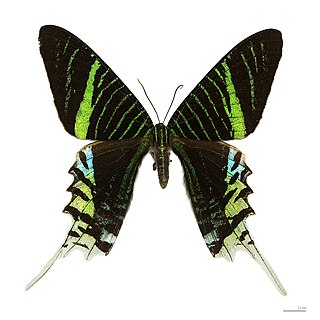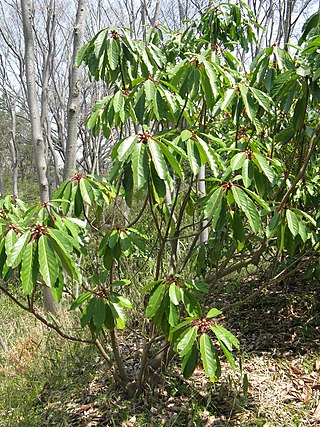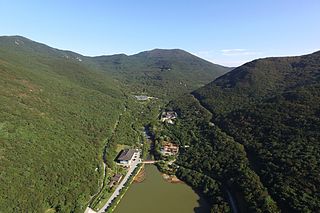
The Uraniidae are a family of moths containing four subfamilies, 90 genera, and roughly 700 species. The family is distributed throughout the tropics of the Americas, Africa and Indo-Australia. Some of the tropical species are known for their bright, butterfly-like colors and are called sunset moths. Such moths are apparently toxic and the bright colors are a warning to predators.
Käthe Hoffmann was a German botanist who described many plant species in New Guinea and South East Asia including Annesijoa novoguineensis. She was a professor at Breslau, German Empire, and made a significant contribution to botany. In one study, she was found to have co-authored or authored 354 land plant species, the sixth-highest number authored by any female scientist. As of May 2020, Plants of the World Online lists 439 accepted genera and species which include Käthe Hoffmann in the authority, in some capacity.

Daphniphyllum is the sole genus in the flowering plant family Daphniphyllaceae and was described as a genus in 1826. The genus includes evergreen shrubs and trees mainly native to east and southeast Asia, but also found in the Indian Subcontinent and New Guinea.

Acropteris iphiata is a species of moth of the family Uraniidae first described by Achille Guenée in 1857. It is found in Japan, China and Korea.

Lyssa zampa, the tropical swallowtail moth or Laos brown butterfly, is a moth of the family Uraniidae. The species was first described by British entomologist Arthur Gardiner Butler in 1869.

Macroglossum saga, the grey-tipped hummingbird hawkmoth, is a moth of the family Sphingidae.

The Southern Korea evergreen forests is a temperate broadleaf and mixed forests ecoregion at the southern end of the Korean Peninsula.

Oroplema plagifera is a moth of the family Uraniidae first described by Arthur Gardiner Butler in 1881. It is found on the Korean Peninsula and in Japan, eastern China, Russia (Sakhalin), Taiwan and northern India.
Oroplema simplex is a species of moth of the family Uraniidae. It is found in southern India and Sri Lanka.

Daphniphyllum macropodum is a shrub or small tree found in China, Japan and Korea. Like all species in the genus Daphniphyllum, D. macropodum is dioecious, that is male and female flowers are borne on different plants. The timber is used in China in construction and furniture making. It is grown as an ornamental plant, chiefly for its foliage.
William Warren was an English entomologist who specialised in Lepidoptera.

Monobolodes prunaria is a species of moth of the family Uraniidae first described by Frederic Moore in 1887. It is found in Sri Lanka, India, Taiwan, Hong Kong, Korea, Japan and possibly Borneo.
The wildlife of South Korea comprises many animals, fungi and plants. Wildlife refers to animal and plant species that live in the wild or natural state such as mountains or rivers. According to the South Korean Ministry of Environment, the rich diversity of South Korea's wildlife includes 8,271 species of plants, 18,117 species of animals and 3,528 species of others. 30,000 species are known to exist in South Korea, but it is expected that there are more than 100,000 species.

Urania boisduvalii is a day-flying moth of the family Uraniidae. It was first described by Félix Édouard Guérin-Méneville in 1829. A genetic analysis of Urania moths gave rise to a phylogenetic tree which places U. boisduvalii as sister to the in-group that includes U. fulgens spp. poeyi, U. fulgens, U. sloanus, U. sloanus, U. leilus and U. leilus spp. brasiliensis.
Urania poeyi is a day-flying moth of the family Uraniidae.

As a public arboretum operated by South Jeolla Province and located in Daemun-ri, Gunoe-myeon, Wando County, it is South Korea's only arboretum with an area of 2,050ha in the warm temperate zone and the country's largest natural habitat for warm temperate forest.
Occurring as a shrub or as a tree, Daphniphyllum majus is a species in the family Daphniphyllaceae. It is found in Mainland Southeast Asia and Yunnan in Zhōngguó/China. Uses of the plant include fuel and smoking-material.
Käthe Rosenthal (1893–1942) was a German botanist. Her major work was on the genus Daphniphyllum. She worked at the Silesian Freidrich-Wilhelms-University in Breslau and at the Prussian Academy of Sciences in Berlin. At the beginning of September 1942, the Jewish scientist was deported from her place of residence in Berlin to the Riga Ghetto, where she was murdered a few days later.

Daphniphyllum calycinum is a species of shrubby plant in the family Daphniphyllaceae. It is found in northern Vietnam and Southeastern Zhōngguó/China. It is used in biodiesel and in lubrication, soap-making and Chinese medicine.












